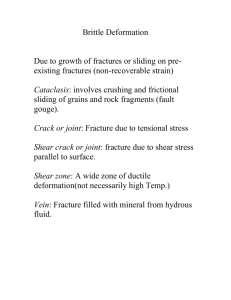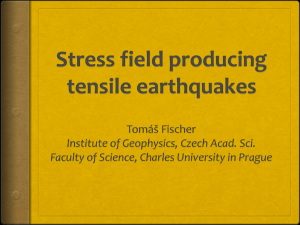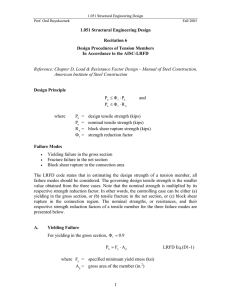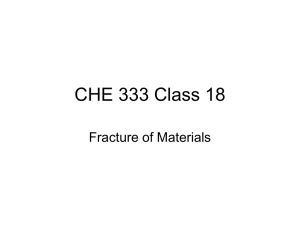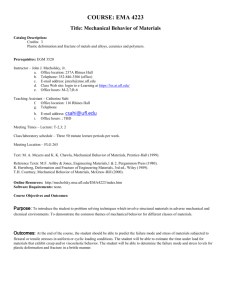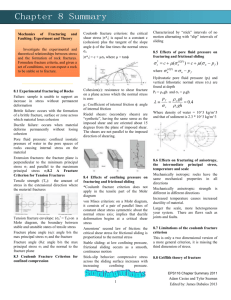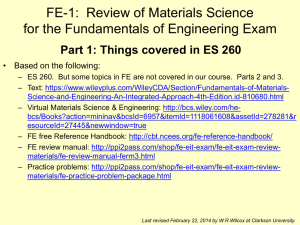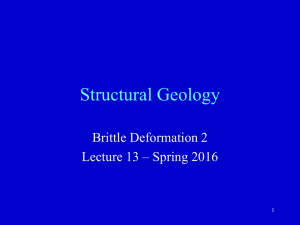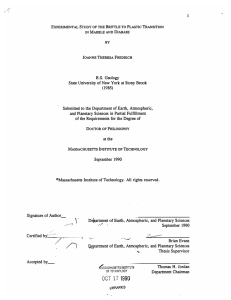Lecture20-earth238
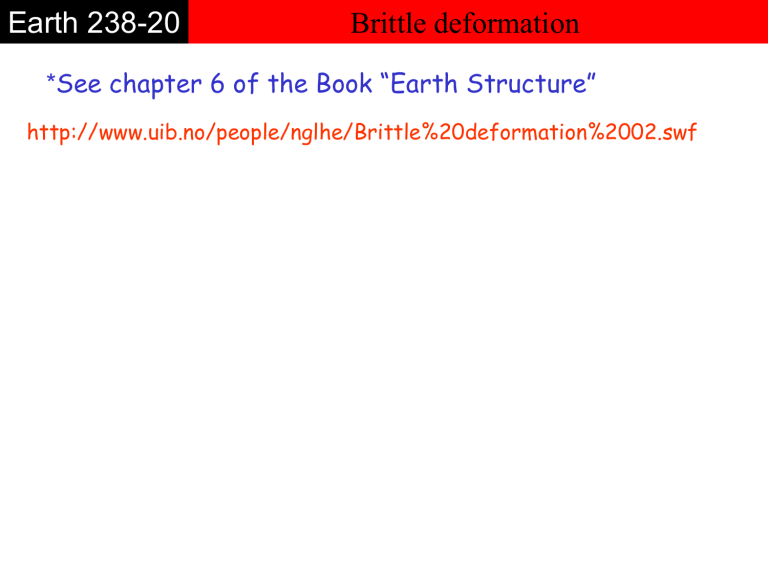
Earth 238-20 Brittle deformation
*
See chapter 6 of the Book “Earth Structure” http://www.uib.no/people/nglhe/Brittle%20deformation%2002.swf
Earth 238-20 Brittle deformation-definition
*
Brittle deformation is nonrecoverable (the deformation remains when the stress is removed).
-Brittle deformation= breaking, fracture.
-This is a permanent change in solid material due to the growth of fracture and/or sliding on fracture surfaces.
At microscopic scale, brittle deformation corresponds to the breaking of bonds between atoms or moleculs
*
Brittle deformation mechanisms
• Located in the first 10-15km of the crust
• At the grain scale:
-Granular flow
-Cataclasis
-Frictionnal sliding
Earth 238-20 What is a fracture?
• Fault
Relative movement parallel to the fracture surface
• Fissure
Opening or aperture
Movement normal to the fracture surface
• Joints
Fracture without visible offset
Parallel or perpendicular to the fracture offset
Earth 238-20 Experimental apparatus
Used to explore the tensile crack development
Used to explore shear fracture development
Earth 238-20
K
1
= s t
Y( p c) 1/2
Tensile cracking (mode I)
K
1 s t is stress intensity factor is far-field tensile stress
Y is geometry of crack (dimensionless) c is half the length of the crack s
3
*Favoured by low confining pressure
*Develop perpendicular to the strain axis s
3 and parallel to the s
1 s
3
*Can be formed by fluid overpressure
Earth 238-20 s r
3s r
C s r
Tensile cracking (mode I)
* Strength paradox : remote stress gets concentrated at the side of flaws inside the material.
Earth 238-20 Tensile cracking (mode I)
C =
2 a/c + 1
C: amount of stress concentration (parameter without dimension) a: long axis of the ellipse c: short axis of the ellipse
*The larger axial ratio is, the greater the stress concentration will be.
*Cracks or discontinuities (Griffith cracks) with high axial ratio will propagate first under stress.
Earth 238-20 Tensile cracking (mode I)
Earth 238-20 Shear fracture (Fault)
Earth 238-20 Shear fractures (mode II and mode III)
* Mode II fracture develop at 20 to 30° to the s
1
Earth 238-20 Shear fractures (mode II and mode III)
Experimentally determined by triaxial compression test.
In triaxial stress, the surrounding pressure s n is added. If uniform (say the pressure of a gas or liquid), then s n the normal stress s
= s
1
s n
s is referred to as differential stress or deviatoric stress is s
1 s n
= s
2
= s
3
Earth 238-20 Shear fractures (mode II and mode III)
Earth 238-20 Failure criteria
*
Anderson theory of failure
Related to Mode I and II fractures
-consequences: relation between the geometry of fault and the associated stress conditions. This is an angular relationship between shear fractures and principal stress axis.
Earth 238-20 Failure criteria
*
Coulomb’s failure criterion s s
= critical shear stress for failure to occur
C = critical shear stress required to initiate slip along a plane oriented so that the normal stress that acts on that plane is zero (cohesion) s n
= normal stress across shear zone at instant of failure
Ф = angle of internal friction s s
= C + s n tg Ф
Earth 238-20 Failure criteria
Failure envelope separates fields of “stable” and “unstable” stress state s s s s s s s n s n s n no failure
(stable)
Failure
(brittle failure) impossible
(unstable)
• Failure envelops=straight lines which slope is μ=tgФ and C is the intercept with the vertical axis
• When s
1
- s
3
(differential stress) is great enough to reach the failure envelops, the failure occurs.
Earth 238-20 Failure criteria
Constructing failure envelopes
-Experimentally determined by triaxial compression test with variable confining pressure by increasing the differential stress.
-the shape of failure envelopes is dependant of the type of rocks
Earth 238-20 Failure criteria
-further work by Otto Mohr on shear-fracture criteria showed that the straight line for Coulomb criterion is valid only for limited range of confining pressures… at lower confining pressures: curves to steeper slope at higher confining pressures: curves to shallower slope
Earth 238-20 Failure criteria
For high confining pressures: plastic deformation begins
• cannot have “failure” envelope…implies brittle
• can approximate “yield” envelope…sample yields plastically two parallel lines that parallel s n axis.
known as Von Mises criterion which is independent of differential stress.
s s s n
Earth 238-20 Failure criteria
Earth 238-20 Brittle deformation
Earth 238-20 Failure criteria
*
Griffith’s failure criterion
based on the assertion that a rock is never homogeneous.
In other words, rocks display always defects as pore or lattice discontinuity.
s s
2 = 4T
0 s n
-4(T
0
) 2 =0
T
0
: Uniaxial tensile strength of the rock
-Micro-discontinuities oriented parallel to the direction of maximum shear stress will grow faster than randomly oriented fractures.
s s
T
0 s n
Earth 238-20 Failure criteria
Earth 238-20 Failure criteria
Earth 238-20 Failure criteria
*Frictional sliding criterion
Because of friction, certain critical shear stress is required before sliding initiates on preexisting fracture s s
= 0.85 s n s s
= 50 MPa + 0.6 s n
Experimental data show that failure criterion for frictional sliding is largely independent of rock type s s
/ s n
= constant
Byerlee’s law for s n
< 200 MPa: s for 200 MPa < s n s
= 0.85 s n
< 2000 MPa: s s
= 50 MPa + 0.6 s n
Earth 238-20 Role of fluids in fracturing
What happens when fluid are present in the pores of a rock ?
Hydrostatic pressure: P f
= ρ.g.h
ρ : Density of water
Earth 238-20
Tensile field
Compressive field
Role of fluids in fracturing s s
= C + ( s n
-p f
)tg Ф
s * n
=s n
-p , called effective pressure
-When the circle reaches the envelop failure, the fracture occurs
-Fluid pressure is equal in all the directions. The radius of Mohr Circle does not change.
f
-Increase in pore pressure moves the Mohr circle to the left.
